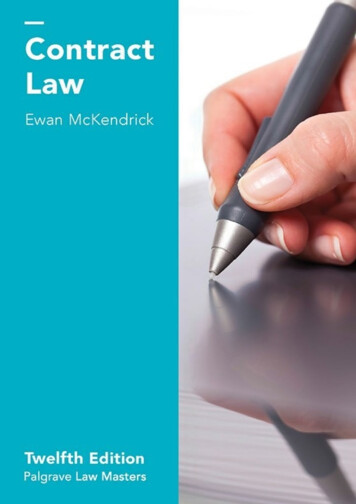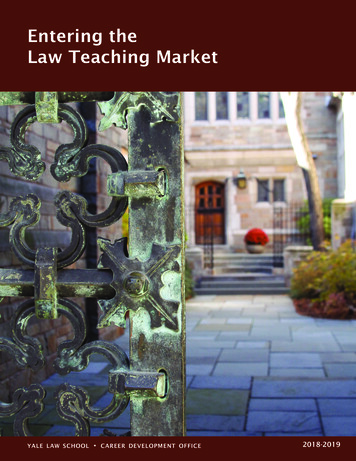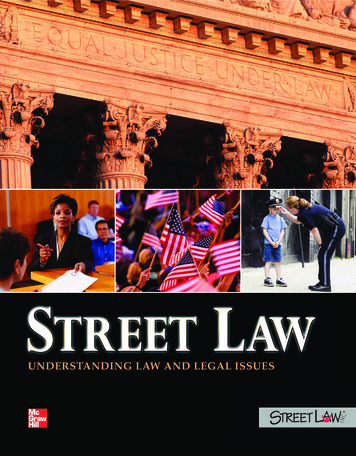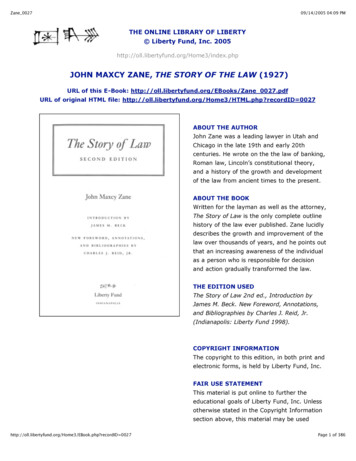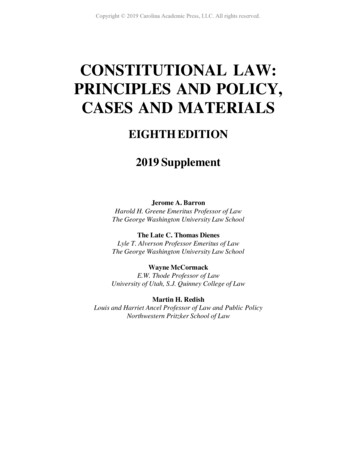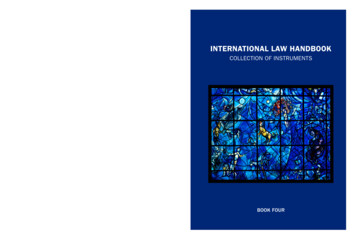
Transcription
International labour lawLaw of cultural relationsInternational trade and investment lawINTERNATIONAL LAW HANDBOOK COLLECTION OF INSTRUMENTSBOOK FOURINTERNATIONAL LAW HANDBOOKCOLLECTION OF INSTRUMENTSBOOK FOURBOOK FOURUN Handbook Package 2.indd 42/28/17 8:49 AM
The photograph on the cover is of a stainedglass window in the United NationsHeadquarters building in New York. Thestaff of the United Nations and Marc Chagalldonated the stained glass panel designedby the French artist as a memorial to DagHammarskjöld and 15 others who died in aplane crash while on a peace mission in theCongo in 1961. Dag Hammarskjöld served asthe second Secretary-General of the UnitedNations from 10 April 1953 until his deathon 18 September 1961. He introduced theconcept of peacekeeping and was awardedDag Hammarskjöldthe Nobel Peace Prize. He also defined therole of an international civil servant based on his personal devotion to theCharter of the United Nations and to public service.In the panel Chagall sought to express the simplicity and beauty of theideals of peace and brotherhood for which the United Nations wasfounded. Symbols of peace and love can be found throughout the panel.In the center is the figure of a young child being kissed on the cheek byan angelic face which emerges from a mass of flowers; the right handside suggests mankind’s yearning for peace, its prophets and its victims,and symbols of law. On the left are depicted motherhood and peoplestruggling for peace.The cover design is courtesy of the graphic designer, Sean Bacon.
INTERNATIONAL LAW HANDBOOKCOLLECTION OF INSTRUMENTSUNITED NATIONS . NEW YORK, 2017
Copyright United Nations, 2017The fundamental goal of the International Law Handbook is to promote the teaching and dissemination of international law around the world under the United Nations Programme of Assistance inthe Teaching, Study, Dissemination and Wider Appreciation of International Law. This publicationmay be reproduced for academic purposes to further this goal anywhere in the world. It may bedownloaded free of charge from the following United Nations websites: http://legal.un.org/poa andhttp://legal.un.org/avl.
Book OneChapter I. Charter of the United Nations and Statute of the International Courtof JusticeChapter II. Law of treatiesChapter III. Subjects of international lawStatesInternational organizationsChapter IV. Diplomatic and consular relationsChapter V. International responsibilityChapter VI. Peaceful settlement of international disputesGeneral instrumentsInstitutional and procedural rulesChapter VII. International peace and securityChapter VIII. International human rights lawMain instrumentsImplementation and monitoringSelf-determinationIndigenous peoplesDevelopmentReligion or beliefBusiness and human rightsRight to a remedy and reparationChapter IX. Movement of persons and international migration lawRefugeesStatelessnessInternally displaced personsMigrant workersBook TwoChapter X. Law of armed conflictMain instrumentsCultural protection in armed conflict and against intentional destructionChapter XI. International criminal lawInternational crimesStatute of limitationsUnited Nations personnelMercenariesMutual legal assistance and extradition
Chapter XI. International criminal law (cont.)International Criminal Tribunal for the former YugoslaviaInternational Criminal Tribunal for RwandaInternational Residual Mechanism for Criminal TribunalsInternational Criminal CourtChapter XII. Disarmament and non-proliferationBook ThreeChapter XIII. Law of the SeaUnited Nations Convention on the Law of the Sea and related instrumentsMaritime disputesChapter XIV. International environmental lawDevelopment and environmentAtmospheric protection and climate changeBiological diversityHazardous activities and substancesDesertificationChapter XV. International watercoursesBook FourChapter XVI. International labour lawFundamental instrumentsDeclarationsChapter XVI. Law of cultural relationsChapter XVIII. International trade and investment lawWorld Trade OrganizationUnited Nations Commission on International Trade LawDevelopmentTrade and investment disputes
INTERNATIONAL LAW HANDBOOKCOLLECTION OF INSTRUMENTSBOOK FOUR
Table of ContentsBook FourPageForeword . . . . . . . . . . . . . . . . . . . . . . . . . . . . . . . . . . . . . . . . . . . . . . .xiChapter XVIInternational labour lawFundamental instruments122. Convention (No. 29) concerning forced or compulsory labour . . . . . . . . . . . . .122.(a) Protocol to Convention (No. 29) concerning forced orcompulsory labour . . . . . . . . . . . . . . . . . . . . . . . . . . . . . . . . .311123. Convention (No. 87) concerning freedom of association and protection ofthe right to organise . . . . . . . . . . . . . . . . . . . . . . . . . . . . . . . . . . . . . .14124. Convention (No. 98) concerning the application of the principles of the rightto organise and to bargain collectively . . . . . . . . . . . . . . . . . . . . . . . . . . .18125. Convention (No. 100) concerning equal remuneration for men and women workersfor work of equal value . . . . . . . . . . . . . . . . . . . . . . . . . . . . . . . . . . . .22126. Convention (No. 105) concerning the abolition of forced labour . . . . . . . . . . . .25127. Convention (No. 111) concerning discrimination in respect of employmentand occupation . . . . . . . . . . . . . . . . . . . . . . . . . . . . . . . . . . . . . . . .27128. Convention (No. 138) concerning minimum age for admission to employment . . .30129. Convention (No. 182) concerning the prohibition and immediate actionfor the elimination of the worst forms of child labour . . . . . . . . . . . . . . . . . .36Declarations130. Tripartite declaration of principles concerning multinational enterprisesand social policy . . . . . . . . . . . . . . . . . . . . . . . . . . . . . . . . . . . . . . . .39131. ILO Declaration on fundamental principles and rights at work . . . . . . . . . . . . .53132. ILO Declaration on social justice for a fair globalization . . . . . . . . . . . . . . . . .56vii
International Law HandbookviiiPageChapter XVIILaw of cultural relations133. Convention on the means of prohibiting and preventing the illicit import,export and transfer of ownership of cultural property . . . . . . . . . . . . . . . . . .67134. Convention concerning the protection of the world cultural and natural heritage . .73135. Convention on the protection of the underwater cultural heritage . . . . . . . . . . .83136. Convention for the safeguarding of the intangible cultural heritage . . . . . . . . . . .97137. Charter on the preservation of digital heritage . . . . . . . . . . . . . . . . . . . . . . .107138. Convention on the protection and promotion of the diversity of cultural expressions111Chapter XVIIIInternational trade and investment lawWorld Trade Organization139. Agreement establishing the World Trade Organization . . . . . . . . . . . . . . . . .127140. Multilateral Agreements on Trade in Goods (Annex 1A of the Agreementestablishing the World Trade Organization) . . . . . . . . . . . . . . . . . . . . . . . .140.(a) General Agreement on Tariffs and Trade 1994. . . . . . . . . . . . . . . . . .136136140.(b) General Agreement on Tariffs and Trade (GATT 1947) . . . . . . . . . . . . .147140.(c) Agreement on agriculture. . . . . . . . . . . . . . . . . . . . . . . . . . . . . .196140.(d) Agreement on the application of sanitary and phytosanitary measures. . . .214140.(e) Agreement on technical barriers to trade. . . . . . . . . . . . . . . . . . . . .225140.(f) Agreement on trade-related investment measures. . . . . . . . . . . . . . . .240140.(g) Agreement on implementation of article vi of the General Agreementon Tariffs and Trade 1994 . . . . . . . . . . . . . . . . . . . . . . . . . . . . .243140.(h) Agreement on implementation of article vii of the General Agreementon Tariffs and Trade 1994. . . . . . . . . . . . . . . . . . . . . . . . . . . . . .262140.(i) Agreement on preshipment inspection. . . . . . . . . . . . . . . . . . . . . .283140.(j) Agreement on rules of origin . . . . . . . . . . . . . . . . . . . . . . . . . . . .290140.(k) Agreement on import licensing procedures. . . . . . . . . . . . . . . . . . . .298140.(l) Agreement on subsidies and countervailing measures. . . . . . . . . . . . . .304140.(m) Agreement on safeguards. . . . . . . . . . . . . . . . . . . . . . . . . . . . . .338140.(n) Agreement on trade facilitation . . . . . . . . . . . . . . . . . . . . . . . . . .344
Table of ContentsixPage141. General Agreement on trade in services (Annex 1B of the Agreementestablishing the World Trade Organization) . . . . . . . . . . . . . . . . . . . . . . . .371142. Agreement on trade-related aspects of intellectual property rights(Annex 1C of the Agreement establishing the World Trade Organization) . . . . . .394United Nations Commission on International Trade Law143. United Nations Convention on contracts for the international sale of goods . . . . .417144. United Nations Convention on independent guarantees andstand-by letters of credit . . . . . . . . . . . . . . . . . . . . . . . . . . . . . . . . . . .436145. United Nations Convention on the assignment of receivables in international trade .444146. United Nations Convention on the use of electronic communicationsin international contracts . . . . . . . . . . . . . . . . . . . . . . . . . . . . . . . . . . .460147. United Nations Convention on contracts for the international carriageof goods wholly or partly by sea . . . . . . . . . . . . . . . . . . . . . . . . . . . . . . .467Development148. Charter of economic rights and duties of States . . . . . . . . . . . . . . . . . . . . . .497Trade and investment disputes149. Convention on the recognition and enforcement of foreign arbitral awards . . . . . .505150. Convention on the settlement of investment disputes between States andnationals of other States . . . . . . . . . . . . . . . . . . . . . . . . . . . . . . . . . . .509151. UNCITRAL Conciliation Rules . . . . . . . . . . . . . . . . . . . . . . . . . . . . . . .558152. Understanding on rules and procedures governing the settlement of disputes(Annex 2 of the Agreement establishing the World Trade Organization) . . . . . . .562153. UNCITRAL Arbitration Rules . . . . . . . . . . . . . . . . . . . . . . . . . . . . . . . .582154. UNCITRAL Rules on transparency in treaty-based investor-State arbitration . . . . .597
ForewordThe International Law Handbook was prepared by the Codification Division of the Officeof Legal Affairs under the United Nations Programme of Assistance in the Teaching, Study, Dissemination and Wider Appreciation of International Law, pursuant to General Assembly resolution 70/116 of 14 December 2015.Ambassador Emmanuel K. Dadzie of Ghana proposed the establishment of this programmewhen he served as Vice-Chairman of the Sixth Committee of the General Assembly at its 18th session in 1963. Following efforts led by Afghanistan, Belgium, Ghana and Ireland, the General Assembly decided, by resolution 2099 (XX) of 20 December 1965, to establish the Programme of Assistanceto contribute towards a better knowledge of international law as a means of strengthening international peace and security and promoting friendly relations and cooperation among States.The International Law Handbook is a collection of instruments used by the Codification Division as study materials for its training courses under the Programme of Assistance. This publicationwas prepared to celebrate the fiftieth anniversary of the establishment of the Programme in 2015 andto promote the teaching and dissemination of international law around the world. It is available onthe United Nations Programme of Assistance website as well as the Audiovisual Library of International Law free of charge.* It may be reproduced for academic purposes to further the teaching anddissemination of international law anywhere in the world.The International Law Handbook is intended to be used as a general work of reference. Itcomprises four books:Book One contains the Charter of the United Nations and the Statute of the InternationalCourt of Justice, as well as instruments relating to the law of treaties, subjects of international law,diplomatic and consular relations, international responsibility, peaceful settlement of internationaldisputes, international peace and security, international human rights law as well as movement ofpersons and international migration law.Book Two contains instruments relating to the law of armed conflict, international criminallaw as well as disarmament and non-proliferation.Book Three contains instruments relating to the law of the sea, international environmentallaw and international watercourses.Book Four contains instruments relating to international labour law, law of cultural relationsas well as international trade and investment law.For ease of reference, each book includes an overview of the content of all four books, as wellas a detailed table of contents for each respective volume.The present collection of international instruments is not exhaustive. The texts incorporateamendments and corrections to the instruments subsequent to their entry into force, as appropriate, and whether or not the amendments have entered into force for all parties. Only the texts of theinstruments as kept in the custody of the respective depositary constitute the authentic versions. TheInternational Law Handbook is issued for information and educational purposes only.*See, respectively, http://legal.un.org/poa/ and http://legal.un.org/avl.xi
Chapter XVIInternational Labour law
Fundamental instruments122. Convention (No. 29) concerning Forced orCompulsory LabourDone at Geneva on 28 June 1930Entry into force: 1 May 1932United Nations, Treaty Series, vol. 39, p. 55; Reg. No. 612, text as modified by the Final Articles RevisionConvention, 1946PreambleThe General Conference of the International Labour Organisation,Having been convened at Geneva by the Governing Body of the International Labour Office,and having met in its Fourteenth Session on 10 June 1930, andHaving decided upon the adoption of certain proposals with regard to forced or compulsorylabour, which is included in the first item on the agenda of the Session, andHaving determined that these proposals shall take the form of an international Convention,Adopts this twenty-eighth day of June of the year one thousand nine hundred and thirty thefollowing Convention, which may be cited as the Forced Labour Convention, 1930, for ratificationby the Members of the International Labour Organisation in accordance with the provisions of theConstitution of the International Labour Organisation:Article 11. Each Member of the International Labour Organisation which ratifies this Conventionundertakes to suppress the use of forced or compulsory labour in all its forms within the shortestpossible period.2. With a view to this complete suppression, recourse to forced or compulsory labour may behad, during the transitional period, for public purposes only and as an exceptional measure, subjectto the conditions and guarantees hereinafter provided.3. At the expiration of a period of five years after the coming into force of this Convention, andwhen the Governing Body of the International Labour Office prepares the report provided for inArticle 31 below, the said Governing Body shall consider the possibility of the suppression of forcedor compulsory labour in all its forms without a further transitional period and the desirability ofplacing this question on the agenda of the Conference.Article 21. For the purposes of this Convention the term “forced or compulsory labour” shall mean allwork or service which is exacted from any person under the menace of any penalty and for whichthe said person has not offered himself voluntarily.2. Nevertheless, for the purposes of this Convention, the term “forced or compulsory labour”shall not include—(a) any work or service exacted in virtue of compulsory military service laws for work of apurely military character;(b) any work or service which forms part of the normal civic obligations of the citizens of afully self-governing country;(c) any work or service exacted from any person as a consequence of a conviction in a courtof law, provided that the said work or service is carried out under the supervision and control of a3
4XVI. International labour lawpublic authority and that the said person is not hired to or placed at the disposal of private individuals, companies or associations;(d) any work or service exacted in cases of emergency, that is to say, in the event of war orof a calamity or threatened calamity, such as fire, flood, famine, earthquake, violent epidemic orepizootic diseases, invasion by animal, insect or vegetable pests, and in general any circumstancethat would endanger the existence or the well-being of the whole or part of the population;(e) minor communal services of a kind which, being performed by the members of the community in the direct interest of the said community, can therefore be considered as normal civicobligations incumbent upon the members of the community, provided that the members of thecommunity or their direct representatives shall have the right to be consulted in regard to the needfor such services.Article 3For the purposes of this Convention the term ”competent authority” shall mean either anauthority of the metropolitan country or the highest central authority in the territory concerned.Article 41. The competent authority shall not impose or permit the imposition of forced or compulsorylabour for the benefit of private individuals, companies or associations.2. Where such forced or compulsory labour for the benefit of private individuals, companiesor associations exists at the date on which a Member’s ratification of this Convention is registeredby the Director-General of the International Labour Office, the Member shall completely suppresssuch forced or compulsory labour from the date on which this Convention comes into force for thatMember.Article 51. No concession granted to private individuals, companies or associations shall involve anyform of forced or compulsory labour for the production or the collection of products which suchprivate individuals, companies or associations utilise or in which they trade.2. Where concessions exist containing provisions involving such forced or compulsory labour,such provisions shall be rescinded as soon as possible, in order to comply with Article 1 of thisConvention.Article 6Officials of the administration, even when they have the duty of encouraging the populations under their charge to engage in some form of labour, shall not put constraint upon the saidpopulations or upon any individual members thereof to work for private individuals, companies orassociations.Article 71. Chiefs who do not exercise administrative functions shall not have recourse to forced orcompulsory labour.2. Chiefs who exercise administrative functions may, with the express permission of the competent authority, have recourse to forced or compulsory labour, subject to the provisions of Article 10 of this Convention.3. Chiefs who are duly recognised and who do not receive adequate remuneration in otherforms may have the enjoyment of personal services, subject to due regulation and provided that allnecessary measures are taken to prevent abuses.
Convention on forced labour5Article 81. The responsibility for every decision to have recourse to forced or compulsory labour shallrest with the highest civil authority in the territory concerned.2. Nevertheless, that authority may delegate powers to the highest local authorities to exactforced or compulsory labour which does not involve the removal of the workers from their placeof habitual residence. That authority may also delegate, for such periods and subject to such conditions as may be laid down in the regulations provided for in Article 23 of this Convention, powersto the highest local authorities to exact forced or compulsory labour which involves the removal ofthe workers from their place of habitual residence for the purpose of facilitating the movement ofofficials of the administration, when on duty, and for the transport of Government stores.Article 9Except as otherwise provided for in Article 10 of this Convention, any authority competentto exact forced or compulsory labour shall, before deciding to have recourse to such labour, satisfyitself—(a) that the work to be done or the service to be rendered is of important direct interest forthe community called upon to do work or render the service;(b)that the work or service is of present or imminent necessity;(c) that it has been impossible to obtain voluntary labour for carrying out the work or rendering the service by the offer of rates of wages and conditions of labour not less favourable thanthose prevailing in the area concerned for similar work or service; and(d) that the work or service will not lay too heavy a burden upon the present population,having regard to the labour available and its capacity to undertake the work.Article 101. Forced or compulsory labour exacted as a tax and forced or compulsory labour to whichrecourse is had for the execution of public works by chiefs who exercise administrative functionsshall be progressively abolished.2. Meanwhile, where forced or compulsory labour is exacted as a tax, and where recourse is hadto forced or compulsory labour for the execution of public works by chiefs who exercise administrative functions, the authority concerned shall first satisfy itself—(a) that the work to be done or the service to be rendered is of important direct interest forthe community called upon to do the work or render the service;(b) that the work or the service is of present or imminent necessity;(c) that the work or service will not lay too heavy a burden upon the present population,having regard to the labour available and its capacity to undertake the work;(d) that the work or service will not entail the removal of the workers from their place ofhabitual residence;(e) that the execution of the work or the rendering of the service will be directed in accordance with the exigencies of religion, social life and agriculture.Article 111. Only adult able-bodied males who are of an apparent age of not less than 18 and not morethan 45 years may be called upon for forced or compulsory labour. Except in respect of the kindsof labour provided for in Article 10 of this Convention, the following limitations and conditionsshall apply:(a) whenever possible prior determination by a medical officer appointed by the administration that the persons concerned are not suffering from any infectious or contagious disease and that
6XVI. International labour lawthey are physically fit for the work required and for the conditions under which it is to be carriedout;(b) exemption of school teachers and pupils and officials of the administration in general;(c) the maintenance in each community of the number of adult able-bodied men indispensable for family and social life;(d) respect for conjugal and family ties.2. For the purposes of subparagraph (c) of the preceding paragraph, the regulations providedfor in Article 23 of this Convention shall fix the proportion of the resident adult able-bodied maleswho may be taken at any one time for forced or compulsory labour, provided always that this proportion shall in no case exceed 25 per cent. In fixing this proportion the competent authority shalltake account of the density of the population, of its social and physical development, of the seasons,and of the work which must be done by the persons concerned on their own behalf in their locality, and, generally, shall have regard to the economic and social necessities of the normal life of thecommunity concerned.Article 121. The maximum period for which any person may be taken for forced or compulsory labourof all kinds in any one period of twelve months shall not exceed sixty days, including the time spentin going to and from the place of work.2. Every person from whom forced or compulsory labour is exacted shall be furnished with acertificate indicating the periods of such labour which he has completed.Article 131. The normal working hours of any person from whom forced or compulsory labour is exactedshall be the same as those prevailing in the case of voluntary labour, and the hours worked in excessof the normal working hours shall be remunerated at the rates prevailing in the case of overtimefor voluntary labour.2. A weekly day of rest shall be granted to all persons from whom forced or compulsory labourof any kind is exacted and this day shall coincide as far as possible with the day fixed by tradition orcustom in the territories or regions concerned.Article 141. With the exception of the forced or compulsory labour provided for in Article 10 of thisConvention, forced or compulsory labour of all kinds shall be remunerated in cash at rates not lessthan those prevailing for similar kinds of work either in the district in which the labour is employedor in the district from which the labour is recruited, whichever may be the higher.2. In the case of labour to which recourse is had by chiefs in the exercise of their administrativefunctions, payment of wages in accordance with the provisions of the preceding paragraph shall beintroduced as soon as possible.3. The wages shall be paid to each worker individually and not to his tribal chief or to anyother authority.4. For the purpose of payment of wages the days spent in travelling to and from the place ofwork shall be counted as working days.5. Nothing in this Article shall prevent ordinary rations being given as a part of wages, suchrations to be at least equivalent in value to the money payment they are taken to represent, butdeductions from wages shall not be made either for the payment of taxes or for special food, clothing or accommodation supplied to a worker for the purpose of maintaining him in a fit conditionto carry on his work under the special conditions of any employment, or for the supply of tools.
Convention on forced labour7Article 151. Any laws or regulations relating to workmen’s compensation for accidents or sickness arising out of the employment of the worker and any laws or regulations providing compensation forthe dependants of deceased or incapacitated workers which are or shall be in force in the territoryconcerned shall be equally applicable to persons from whom forced or compulsory labour is exactedand to voluntary workers.2. In any case it shall be an obligation on any authority employing any worker on forced orcompulsory labour to ensure the subsistence of any such worker who, by accident or sickness arisingout of his employment, is rendered wholly or partially incapable of providing for himself, and totake measures to ensure the maintenance of any persons actually dependent upon such a worker inthe event of his incapacity or decease arising out of his employment.Article 161. Except in cases of special necessity, persons from whom forced or compulsory labour isexacted shall not be transferred to districts where the food and climate differ so considerably fromthose to which they have been accustomed as to endanger their health.2. In no case shall the transfer of such workers be permitted unless all measures relating tohygiene and accommodation which are necessary to adapt such workers to the conditions and tosafeguard their health can be strictly applied.3. When such transfer cannot be avoided, measures of gradual habituation to the new conditions of diet and of climate shall be adopted on competent medical advice.4. In cases where such workers are required to perform regular work to which they are notaccustomed, measures shall be taken to ensure their habituation to it, especially as regards progressive training, the hours of work and the provision of rest intervals, and any increase or ameliorationof diet which may be necessary.Article 17Before permitting recourse to forced or compulsory labour for works of construction or maintenance which entail the workers remaining at the workplaces for considerable periods, the competent authority shall satisfy itself—(1) that all necessary measures are taken to safeguard the health of the workers and to guarantee the necessary medical care, and, in particular, (a) that the workers are medically examinedbefore commencing the work and at fixed intervals during the period of service, (b) that there is anadequate medical staff, provided with the dispensaries, infirmaries, hospitals and equipment necessary to meet all requirements, and (c) that the sanitary conditions of the workplaces, the supplyof drinking water, food, fuel, and cooking utensils, and, where necessary, of housing and clothing,are satisfactory;(2) that definite arrangements are made to ensure the subsistence of the fa
The International Law Handbook is intended to be used as a general work of reference. It comprises four books: Book One contains the Charter of the United Nations and the Statute of the International Court of Justice, as well as instruments relating to the law of treaties, subjects of international law,




